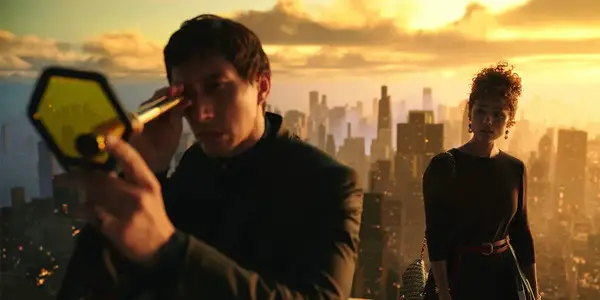
It’s been a few days since Francis Ford Coppola’s Megalopolis premiered at Cannes, and I’m still struggling to find the exact words to describe this monstrous opus of a film. Is it brilliant labour of chaotic love to the cinematic art form, or simply a laborious mess of boundless magnitudes? The answer is likely somewhere in the middle, but what’s abundantly clear is that Megalopolis bleeds with the artistic energy of a master who has nothing to lose. You’ll be hard pressed to find another film that’s as equally divisive and engrossing – be it good or bad – not only at this year’s edition of the festival, but possibly ever in the history of cinema.
Having been in development since the late 1970s, the film centers around New Rome, a city in need of reinvention following a disastrous event. In comes Cesar Catalina (Adam Driver), an architect with a vision to transform the city, which is vehemently opposed by Mayor Franklyn Cicero (Giancarlo Esposito). Catalina also has the ability to stop time, forms a relationship with Cicero’s daughter, Julia (Nathalie Emmanuel), while being pestered by a news reporter named Wow Platinum (Aubrey Plaza, as uninhibited as ever). There’s also supporting appearances by Shia LaBeouf, Jon Voight, Laurence Fishburne, Talia Shire and Jason Schwartzman.
Was this all intentional?
As a film, Megalopolis feels almost schizophrenic by design. While freely shifting between genres and tonalities, it also has the look of a low-budget television movie masquerading as a monumental epic. With a self-funded budget north of a million dollars, Coppola must’ve been able to hire a better visual effects team, right? Perhaps he did, but the growing reports of a disastrous production might in fact be true. Or, just maybe, the cheap visuals and campy dialogue were purposeful decisions in order to convey Coppola’s vision of an evolving cinematic experience.
source: Cannes Film Festival
If this were any other film, I doubt there’d be discourse on this level. But because of how bombastic, yet somehow endearing, Megalopolis is, these conversations feels necessary. Not because it’s a Francis Ford Coppola film marred with production woes, but because the film itself simply invites deeper analysis. The messiness of it all somehow feels controlled and deliberate. There’s even a scene in the film where an actual human being steps out in front of the screen to interview Driver’s on-screen character during a press conference. Not surprisingly, this was met with both laughter and shock, but also felt stylistically appropriate given everything that came before it. For the most part, the film’s narration is relatively non-sensible, with and dialogue and performances that aim to match this level of ridiculousness. Plaza, in particular, is completely unhinged from beginning to end. Coming from such a revered master of his craft, it’s hard to reconcile this level of chaos as anything but intentional.
The evolving mastermind of a living legend
No matter what the final product ends up being, anything coming from the mind of Coppola will forever be enamoured as an extension of his legendary filmography. And weighted against classics like The Godfather and Apocalypse Now, the disparity in quality is stark by any metric. But compared to his more recent films, specifically Tetro and Twixt, and Megalopolis’ experimental leaning ideations seem like a natural progression of his evolving style as an artist.
source: Cannes Film Festival
In many ways, Coppola’s creation of Megalopolis almost shares a common through line with the Roman Empire, which the filmmaker obviously adores. His obsession with the rise and fall of the Romans isn’t just mentioned on multiple occasions throughout the film, but also seems to serve as his guiding compass when it comes to his thoughts on cinema itself. The film really leans on the Roman Empire’s lack of evolution as a reason for its eventual destruction, and perhaps Coppola fears the same for the cinematic art form as well.
His recent filmography suggests a cautionary tone against creating cinema that is more stylistically refined, as this direction might eventually result in the self-catastrophization of the art form. And with Megalopolis, that evolution towards something less refined, and perhaps, in his mind, more ingenious, is what’s necessary in order for cinema to survive. It might be the only way to fully understand why the film is the way it is, which seems to be spirited by an overall affliction of sensible grandeur. That sensibility might not be apparent on the surface, but does come through on further reflection.
Final Thoughts
When all is said and done, the question remains, is Megalopolis a good film? Answering with a definitive yes is certainly a hard feat, but one could easily make the argument that Megalopolis is good cinema. It’s rare for a film to entice analytic discourse among the masses, and to be fair, there certainly is a method to Coppola’s raging madness. At the same time, this madness has also resulted in a film that is truly batshit crazy. It’s truly difficult to qualify the beast of an experience that is Megalopolis, and because of that, there’s an undefinable elegance to Coppola’s twilight magnum opus. As much of a disaster this is, it sure is a beautiful one.
Does content like this matter to you?
Become a Member and support film journalism. Unlock access to all of Film Inquiry`s great articles. Join a community of like-minded readers who are passionate about cinema – get access to our private members Network, give back to independent filmmakers, and more.








